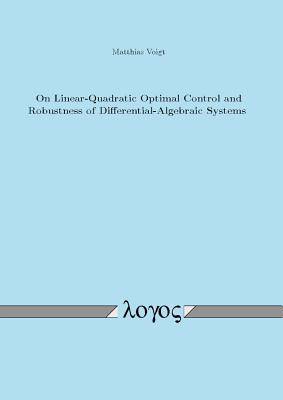
- Afhalen na 1 uur in een winkel met voorraad
- Gratis thuislevering in België vanaf € 30
- Ruim aanbod met 7 miljoen producten
- Afhalen na 1 uur in een winkel met voorraad
- Gratis thuislevering in België vanaf € 30
- Ruim aanbod met 7 miljoen producten
Zoeken
On Linear-Quadratic Optimal Control and Robustness of Differential-Algebraic Systems
Matthias Voigt
Paperback | Engels
€ 98,45
+ 196 punten
Omschrijving
This thesis considers the linear-quadratic optimal control problem for differential-algebraic systems. In this first part, a complete theoretical analysis of this problem is presented. The basis is a new differential-algebraic version of the Kalman-Yakubovich-Popov (KYP) lemma. One focus is the analysis of the solution structure of the associated descriptor KYP inequality. In particular, rank-minimizing, stabilizing, and extremal solutions are characterized which gives a deep insight into the structure of the problem. Further contributions include new relations of the descriptor KYP inequality to structured matrix pencils, conditions for the existence of nonpositive solutions, and the application of the new theory to the characterization of dissipative systems and the factorization of rational matrix-valued functions. The second part of this thesis focuses on robustness questions, i.e., the influence of perturbations on system properties like dissipativity and stability is discussed. Characterizations for the distance of a dissipative systems to the set of non-dissipative systems are given which lead to a numerical method for computing this distance. Furthermore, the problem of computing the H-infinity-norm of a large-scale differential-algebraic system is considered. Two approaches for this computation are introduced and compared to each other.
Specificaties
Betrokkenen
- Auteur(s):
- Uitgeverij:
Inhoud
- Aantal bladzijden:
- 310
- Taal:
- Engels
Eigenschappen
- Productcode (EAN):
- 9783832541187
- Verschijningsdatum:
- 30/09/2015
- Uitvoering:
- Paperback
- Formaat:
- Trade paperback (VS)
- Afmetingen:
- 145 mm x 211 mm
- Gewicht:
- 517 g

Alleen bij Standaard Boekhandel
+ 196 punten op je klantenkaart van Standaard Boekhandel
Beoordelingen
We publiceren alleen reviews die voldoen aan de voorwaarden voor reviews. Bekijk onze voorwaarden voor reviews.








